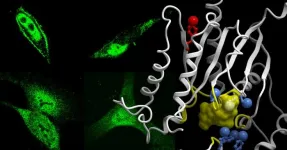(Press-News.org) (Santa Barbara, Calif.) — Thirty by thirty. It’s an ambitious answer to growing calls for protecting more of our planet’s surface. The goal is to conserve 30% of the Earth’s oceans, lands and freshwaters by 2030. While this may seem a lofty aim, the diversity and coverage of conservation areas today might be greater than what’s currently recognized by global tracking systems.
An international team of conservation researchers and practitioners, led by scientists at UC Santa Barbara and The Nature Conservancy, has developed an inclusive inventory approach for tracking global conservation areas, with an emphasis on local data and expertise. Applying this approach across the nine countries spanning the Amazon Rainforest identified a wide array of conservation areas with greater diversity and area coverage than existing tracking systems showed. The team published their findings in the journal One Earth.
The study offers empirical guidelines for how different actors — including researchers, governments, non-state actors and donors — can embrace this broader scope of area-based conservation in research and decision-making. “The baseline data generated from this inventory will also allow researchers to assess the relative effectiveness of different types of conservation governance systems,” said co-lead author Yifan He, a doctoral student at UC Santa Barbara’s Bren School of Environmental Science & Management.
Successfully conserving 30% of Earth’s surface by 2030 will require properly recognizing and tracking existing conservation efforts. In contrast to current tracking systems, the authors claim that their approach will provide a more comprehensive starting point for discussing what should count towards a nation’s progress in achieving its share of the 30% target.
“It is important to ensure inclusivity and transparency around the criteria and the decision-making process,” said study co-lead author Siyu Qin, a researcher at The Nature Conservancy. “Knowing who is governing these lands and how, as well as recognizing their visions related to conservation, is the first step to collectively planning for a fair and feasible future for our planet.”
Despite efforts to expand their scope, current tracking systems still omit many forms of area-based governance related to conservation. For example, these systems do not recognize community-based natural resources management, payment for ecosystem services programs, or eco-certified production areas. Often this is a result of deficient data or reliance on government reporting.
The authors’ proposal identifies conservation areas through sources such as the scientific literature, legal documents and knowledge from Indigenous peoples and local communities. They demonstrated the usefulness of the proposed approach by comprehensively mapping area-based conservation in the Amazonian countries (Bolivia, Brazil, Colombia, Ecuador, French Guiana, Guyana, Peru, Suriname and Venezuela).
Further, they researchers identified a broad scope of area-based conservation governance systems that collectively cover more than 40% of land in these countries; official databases from the same period estimated only a 28% area coverage. Additionally, the official databases also contained fewer types of governance systems: “Some countries are missing two, others are missing up to seven,” said He.
“Progress has been made in the official recognition of diverse conservation areas, including ‘Other Effective Conservation Measures’ in the Global Biodiversity Framework. However, many areas contributing to biodiversity conservation remain unrecognized in official databases due to specific reporting processes and differing objectives of site owners,” said He. “Thus, we need complementary, society-led approaches to acknowledge these areas and direct resources to them.”
The authors also noted that, globally, about 45% of lands are customarily held, and potentially conserved, by Indigenous peoples and local communities. In addition, at least 220,000 square kilometers (around 85,000 square miles) of forests around the world — an area roughly the size of Utah — have been set aside for conservation under the Forest Stewardship Council eco-certification. About 150,000 km2 (58,000 mi2) comprise biodiversity offset projects. Pathways to support, assess and count these areas toward conservation targets remain to be clarified.
Many nations have committed to conserve 30% of global lands and water by 2030. In fact, the 30x30 initiative was codified as Target 3 of the 2022 Kunming-Montreal Global Biodiversity Framework, as agreed through the Convention for Biological Diversity. Achieving these goals will require understanding what forms of area-based conservation already exist, how much and where.
“We hope this inventory approach can be a starting point for conservation planning efforts,” explained He. “Before deciding where to create new conservation areas or how to prioritize limited resources, we first need to understand what is already out there and how these sites are governed.”
END
A novel approach to tracking conservation reveals more areas may be conserved than currently accounted for
The insights are crucial for meeting the goal of protecting 30% of Earth by 2030
2024-06-05
ELSE PRESS RELEASES FROM THIS DATE:
Commonly used alcohol-based mouthwash brand disrupts the balance of your oral microbiome, scientists say
2024-06-05
SUMMARY
Researchers have identified a significant change in composition and abundance of bacteria in study participants’ oral microbiomes after using a popular brand of alcohol-based mouthwash.
The oral microbiome is the community of bacteria that live in the mouth, they help us digest our food and keep our mouth healthy.
Researchers found that two species of opportunistic bacteria were significantly more abundant in the mouth after daily use of the alcohol-based mouthwash, Fusobacterium nucleatum and Streptococcus anginosus. ...
Injury prediction rule could decrease radiographic imaging exposure in children, study shows
2024-06-05
(COLUMBUS, Ohio) – While cervical spine injuries (CSI) are uncommon in children, they can be potentially devastating, resulting in quadriplegia – paralysis below the neck affecting both arms and both legs. Detecting CSIs in a clinical setting often requires imaging such as X-rays and computed tomography (CT) scans, both of which expose children to radiation, which can cause other health issues over time.
In a study published today in The Lancet Child & Adolescent Health, researchers in the Pediatric Emergency Care Applied Research Network (PECARN) – led by Julie Leonard, MD, MPH at Nationwide Children’s Hospital –created a highly accurate ...
Rate of global warming caused by humans at an all-time high say scientists
2024-06-05
University of Leeds press release
UNDER EMBARGO UNTIL 00.01 UK BST, 5 JUNE 2024 (19.01 US ET, 4 JUNE 2024)
The second annual Indicators of Global Climate Change report, which is led by the University of Leeds, reveals that human-induced warming has risen to 1.19 °C over the past decade (2014-2023) – an increase from the 1.14 °C seen in 2013-2022 (set out in last year’s report).
Looking at 2023 in isolation, warming caused by human activity reached 1.3 °C. This ...
Housing associations can be “change makers” for communities, says whitepaper
2024-06-05
Housing associations are being urged to step out of their traditional role to deliver change in deprived areas and help people into work or entrepreneurship.
The call comes in a whitepaper published today by the University of East Anglia (UEA), written in response to how the UK levelling up policy agenda has so far failed to deliver results for constituents in the communities it is designed to help.
It follows a £10.8M Increase Valorisation Sociale (INCREASE VS) project, which showed how housing associations can go ...
Women’s mental agility is better when they’re on their period
2024-06-05
Participants reacted quicker and made fewer errors during menstruation, despite believing their performance would be worse, according to new research from UCL and the Institute of Sport, Exercise & Health (ISEH).
The study, published in Neuropsychologia, is the first to assess sport-related cognition during the menstrual cycle and is part of a larger research project supported by the FIFA Research Scholarship.
The findings act as a proof-of-principle that specific types of cognition fluctuate throughout the ...
AIs are irrational, but not in the same way that humans are
2024-06-05
Large Language Models behind popular generative AI platforms like ChatGPT gave different answers when asked to respond to the same reasoning test and didn’t improve when given additional context, finds a new study from researchers at UCL.
The study, published in Royal Society Open Science, tested the most advanced Large Language Models (LLMs) using cognitive psychology tests to gauge their capacity for reasoning. The results highlight the importance of understanding how these AIs ‘think’ before entrusting them with tasks, particularly those involving decision-making.
In recent years, the LLMs ...
UMass Amherst to join $90M US National Science Foundation large-scale research infrastructure for education
2024-06-04
June 4, 2024
UMass Amherst to Join $90M US National Science Foundation large-scale research infrastructure for education
Platform brings together institutions, digital learning and a world-class team to enable research studies to inform efficacy, improvement and innovation in teaching and learning
AMHERST, Mass. – The Manning College of Information and Computer Sciences at the University of Massachusetts Amherst has joined the newly announced U.S. National Science Foundation’s (NSF) SafeInsights, a five-year, $90 million research and development infrastructure for inclusive education ...
Researchers discover neural circuit involved in compulsive eating even without hunger
2024-06-04
For the first time, researchers have identified a group of neurons deep in the brain that are associated directly with compulsive eating and food craving. The discovery is reported in an article published in Nature Communications by researchers at the University of California, Los Angeles (UCLA) in the United States and the Federal University of the ABC (UFABC) in São Bernardo do Campo, São Paulo state (Brazil).
The neurons are located in the periaqueductal gray, a region of the midbrain at the top of the brainstem, and are known as vesicular ...
Accelerating the R&D of wearable tech: Combining collaborative robotics, AI
2024-06-04
College Park, Md. — Engineers at the University of Maryland (UMD) have developed a model that combines machine learning and collaborative robotics to overcome challenges in the design of materials used in wearable green tech.
Led by Po-Yen Chen, assistant professor in UMD's Department of Chemical and Biomolecular Engineering, the accelerated method to create aerogel materials used in wearable heating applications – published June 1 in the journal Nature Communications – could automate design processes for new materials.
Similar to water-based ...
Chasing down a cellular ‘short circuit’
2024-06-04
A group of researchers at University of California San Diego has identified the cause of a “short-circuit” in cellular pathways, a discovery that sheds new light on the genesis of a number of human diseases.
The recent study, published in the journal Science Signaling, explores the biochemical mechanism that can interrupt the cellular communication chain — a disruptive interaction that Pradipta Ghosh, M.D., likens to a game-ending “buzzer.” Ghosh, a professor in the Departments of Medicine and Cellular and Molecular Medicine ...
LAST 30 PRESS RELEASES:
What causes some people’s gut microbes to produce high alcohol levels?
Global study reveals widespread burning of plastic for heating and cooking
MIT study shows pills that communicate from the stomach could improve medication adherence
Searching for the centromere: diversity in pathways key for cell division
Behind nature’s blueprints
Researchers search for why some people’s gut microbes produce high alcohol levels
Researchers find promising new way to boost the immune response to cancer
Coffee as a staining agent substitute in electron microscopy
Revealing the diversity of olfactory receptors in hagfish and its implications for early vertebrate evolution
Development of an ultrasonic sensor capable of cuffless, non-invasive blood pressure measurement
Longer treatment with medications for opioid use disorder is associated with greater probability of survival
Strategy over morality can help conservation campaigns reduce ivory demand, research shows
Rising temperatures reshape microbial carbon cycling during animal carcass decomposition in water
Achieving ultra-low-power explosive jumps via locust bio-hybrid muscle actuators
Plant-derived phenolic acids revive the power of tetracycline against drug-resistant bacteria
Cooperation: A costly affair in bacterial social behaviour?
Viruses in wastewater: Silent drivers of pollution removal and antibiotic resistance
Sub-iethal water disinfection may accelerate the spread of antibiotic resistance
Three in four new Australian moms struggle with body image
Post-stroke injection protects the brain in preclinical study
Cardiovascular risk score predicts multiple eye diseases
Health: estimated one in ten British adults used or interested in GLP-1 medications for weight loss
Exercise to treat depression yields similar results to therapy
Whooping cough vaccination for pregnant women strengthens babies’ immune system
Dramatic decline in new cases of orphanhood in Uganda driven by HIV treatment and prevention programs
Stopping weight loss drugs linked to weight regain and reversal of heart health markers
Higher intake of food preservatives linked to increased cancer risk
Mass General Brigham–developed cholera vaccine completes phase 1 trial
First experimental validation of a “150-year-old chemical common sense” direct visualization of the molecular structural changes in the ultrafast anthracene [4+4] photocycloaddition reaction
Lack of support for people on weight loss drugs leaves them vulnerable to nutritional deficiencies, say experts
[Press-News.org] A novel approach to tracking conservation reveals more areas may be conserved than currently accounted forThe insights are crucial for meeting the goal of protecting 30% of Earth by 2030


